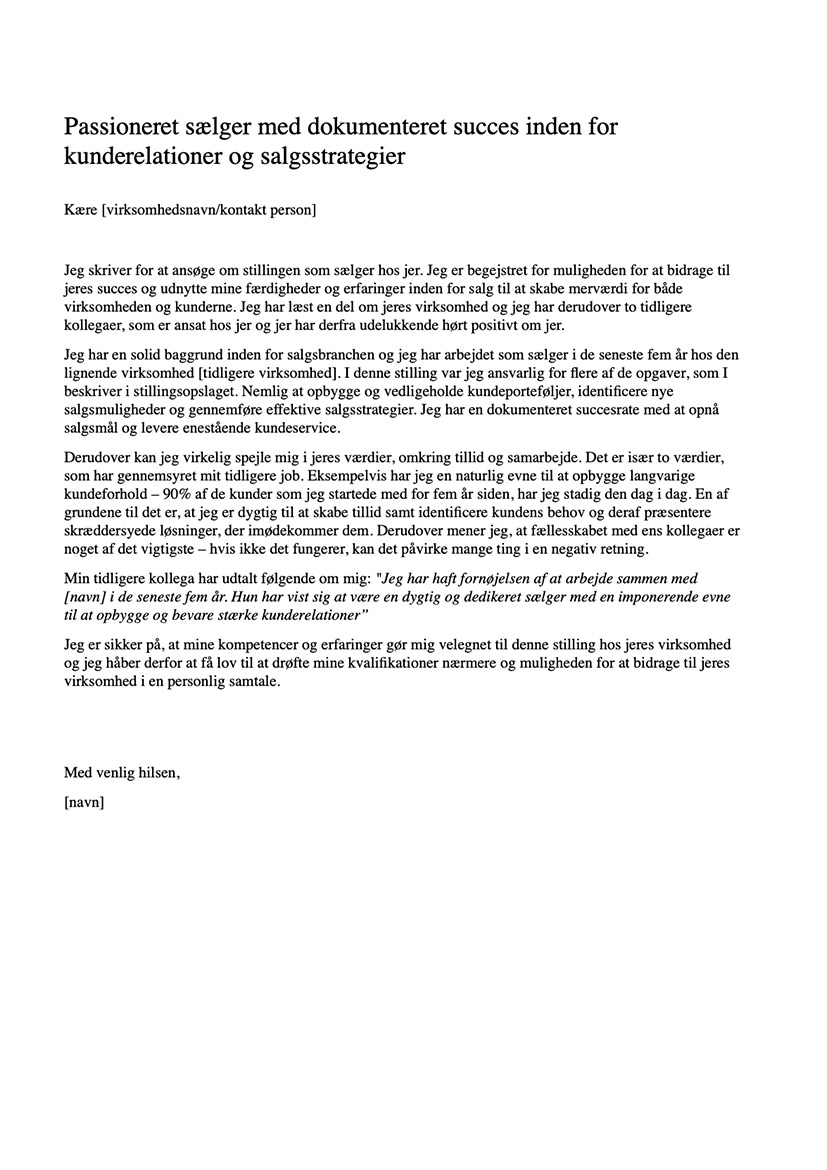Your browser (Safari 1.0) is more than 3 years old.
We recommend that you upgrade to the latest version. Otherwise we cannot guarantee that all functionality on Jobindex will work correctly.

How to create your CV – a complete guide
A CV is often the first thing companies read when they receive applications for a vacant position. In other words, your CV is where you can show the company what you can do and how your experience is relevant to the job.

Checklist: How to write a good CV
- Make sure your CV gives a quick overview.
- Start with your most recent experience first — reverse chronology.
- Tailor your CV to each job you apply for.
- Use clear headings and bullet points to make it easy to skim.
Your CV should give a potential employer a quick and simple overview of your experience, education and skills. The employer is likely to skim your CV in the first instance, so you need to be sharp and focused in your writing and provide a simple overview of the content.
We make it easy for you
Structuring your CV can be tricky – in our Q&A you will get all the best CV tips. Learn more about what a CV looks like, what it typically contains and what it should be able to do. However, here are 3 good tips you can take away with you:
- Create a rough CV. This is a draft with all your general information. When you apply for a specific job, you should sort, highlight and possibly elaborate on the information and experience that is important for that particular job.
- Tailor your CV to the specific job you are applying for. Employers are interested in seeing a CV that shows you have thought about how you suit the role.
- Structure your CV in reverse chronological order, listing your most recent work experience and education first. A CV is typically 1–4 pages long.
Let relevant jobs find their way to you. You can remain anonymous.
Upload your CVView your CV from the company’s perspective
It’s always a good idea to look at your CV through the eyes of the company. When companies are looking for a new employee, they might receive 100, 200, or even more than 300 CVs and applications.
Keep in mind that companies are often under pressure when reviewing so many CVs. Your job is to make it as easy as possible for the company to understand your profile and professional experience. Help the company clearly see the connection between the job description and you as a candidate.
Remember: Your CV won’t be read thoroughly at first glance. It will be skimmed by the company in just 30–60 seconds. Your task is to ensure that they quickly find what they’re looking for. So, read the job ad carefully. It should be clear that there’s a link between your experience and what the company is seeking.
All the basics of a CV
Here you’ll find answers to the most common questions about CVs — from how to create and structure one, to length, layout, font, and profile text. In short: everything you need to know to craft a professional and targeted CV that captures the employer’s attention.
A CV describes what you have done and achieved in previous jobs and through your education. A CV is retrospective and describes what you have done.
A cover letter, on the other hand, is forward-looking, as it describes how you could utilise your skills and experience in the new position. Also check out our guide toa great cover letter here..
Your CV should focus on the most important things you have achieved. And you can elaborate on this in the cover letter itself.
The easiest way to create a CV is to use a Word template. Or you can create a CV here on Jobindex and then print it out.
Create your CV here – for free..
Your CV should be in reverse chronological order, meaning you should start with your most recent achievements first. This applies to work experience and education.
However, no rule is without exception. If you are a recent graduate, you can start with your education and then work experience.
Remember to include start and end dates for previous employment and education.
Also, make your CV easy to read by using headings, appropriately sized letters and not too much text. You can use bullet points, and remember that your CV should be a minimum of 2–3 pages.
A CV should be structured in reverse chronological order, and as a recent graduate you may have been working alongside your studies.
However, when you are a recent graduate looking for your first “real” job, it is your education that matters most. Therefore, you should start by outlining your education and then your work experience.
Of course, it depends on your experience. However, unlike a cover letter, a CV can be longer and is typically 1–4 pages.
It is important that your CV is easy to read. You can achieve this by using multiple headings, appropriately sized letters and by using bullet points.
Writing a targeted CV is not just about showcasing your experience — it’s also about knowing what to leave out. But how far back should you actually go in your career, and what deserves to be included?
In general, your CV should focus on the last 10–15 years of your career, as this is usually the experience most relevant to employers. However, if your most relevant experience lies further back, you can still include it — just make sure to present it briefly and clearly.
Your oldest experiences don’t need much space. A smart solution is to group them under a section such as “Other work experience”, where you list positions and companies without detailed descriptions. This way, you keep your CV clear and targeted to the role you are applying for.
The sections (and headings) that your CV should include are:
A brief introduction
Start with an introduction, where you introduce yourself and your profile in 5–10 lines. Focus on what is relevant to the particular job you are applying for.
Work experience
A strong CV includes only the professional experience relevant to the job you’re applying for. Therefore, you don’t need to include all your work experience when applying.
When writing the employment history section, consider carefully which roles and positions are relevant to highlight in your CV.
As you describe previous employment, ask yourself: “How does my time in this position demonstrate that I’m capable of handling the new job I’m applying for?”
When you tailor your professional experience to match the job, the company can easily see how you fit the role. You want to ensure your CV is completely aligned with the job requirements, clearly demonstrating your relevance as a candidate.
Once you’ve selected your relevant experience, list your key and most relevant tasks in bullet points. Expand on your achievements and responsibilities in relation to the position you’re applying for.
Education
Write the most relevant things about your education. Here you can list the most important subjects and the results you have achieved. Describe what is relevant to the position.
Relevant courses
Briefly mention the courses you have taken that may be relevant to the position.
IT skills
Outline your IT skills if they are relevant to the job.
Your language skills
Describe your level of fluency in relevant languages.
References
List any references who the company can contact.
Other relevant points
Add anything else that might be relevant at the end.
A good CV layout makes it easy for the employer to skim your CV and quickly get an overview of your skills. On average, companies spend only one minute assessing a CV in the initial screening round, so it’s important to make a strong impression right away.
To ensure your CV grabs attention, choose a professional, appealing, and well-structured CV template. You can further optimise the layout by:
- Using fresh colours – ideally the company’s own colours to show you’ve done your research and tailored your CV specifically to them.
- Creating a clear structure with clear headings, short sections, and bullet points.
- Choosing an easy-to-read font that works well both on screen and in print.
- Keeping content short and precise – employers prefer concise sentences and bullet points over long text blocks.
Bonus tip: Always save your CV as a PDF to ensure the layout remains intact when you send it to the employer.
When creating your CV, the font plays an important role in both readability and visual appeal. A professional and easy-to-read font ensures that your CV looks sharp and is easy to navigate — especially since most employers will be reading it on a computer screen.
The best fonts for a CV
To ensure the best reading experience for employers, we recommend the following fonts:
- Calibri – modern and easy to read
- Helvetica – clean and elegant
- Arial – classic and widely used
- Verdana – excellent for on-screen reading
Regardless of which font you choose, you should use black text and keep the font size between 10–12 pt for optimal readability.
It is important to write an effective CV headline, as this is the very first thing an employer sees when reading your CV. A headline in your CV acts as your initial professional introduction.
You can think of it as a compact presentation of your qualifications, experience, and skills.
The benefits of a CV headline
- You show your value from the very first line.
- You capture the employer’s attention.
- You position yourself as a strong candidate for the job.
Examples of effective CV headlines
Here are some strong CV headlines, with the values they communicate:
- Young, ambitious, and service-minded Sales Assistant – immediately gives a clear idea of age, drive, and area of expertise.
- Experienced Project Manager with a focus on innovation – highlights leadership experience and a passion for innovative solutions.
- Creative Marketing Professional with 5 years’ experience – underlines creativity alongside solid marketing experience.
- Dedicated and efficient Communications Consultant with 10+ years’ experience – shows both a decade of experience and strong commitment.
- Experienced Pedagogue specialised in child well-being and development – signals niche expertise that is attractive for specific roles.
- Experienced Carpenter seeking a role as Project Manager in construction – shows readiness to advance and specialise further.
- Recent Nursing Graduate from University College Copenhagen – highlights fresh knowledge, education, and location.
- Caring and structured Social and Health Care Assistant – combines technical skills with empathy, ideal for roles requiring both.
A CV headline makes a strong impression by being clear, precise, and focused. It sparks the employer’s imagination, helping them quickly picture what you are like as an employee.
Tips for your CV headline
- Focus on relevant skills – choose keywords from the job posting that clearly connect your competencies to the role.
- Tailor it to the job description – adapt your CV headline for each application.
- Keep the language clear and concise – avoid filler words and keep it simple.
Writing a strong CV profile text
The next thing an employer reads is your CV profile text — a short description of 5–8 sentences covering your personal and professional profile.
Your profile text should naturally build on your headline and encourage the employer to keep reading.
Your headings can use a slightly more creative font, but make sure it visually matches the rest of your CV. Avoid making the lines too long, as this can make the text harder to read. We recommend a margin of 3 cm to give your CV an airy and well-structured layout.
By choosing the right font and a balanced layout, you ensure that your CV appears professional and easily accessible to recruiters.
Some managers and recruitment consultants only want to see a CV. If this is the case, you may want to create a motivational CV. Here you can elaborate on your CV and include some of the content you would otherwise include in your cover letter.
Do you need inspiration for your cover letter or motivational CV? Click here for our guide to writing a great cover letter.
You can describe your professional experience more effectively by using active, action-oriented verbs such as “support”, “coordinate”, “actively contribute to”, “ensure”, and similar terms.
When you describe your experience this way in your CV, you give the company a clearer impression of your experience and a broader understanding of your skills.
Your CV becomes much more compelling if you can demonstrate linguistically how you’ve performed your tasks, thus placing your competencies in context.
Other good verbs to use in a CV include:
- Assisted
- Optimised
- Identified
- Executed
- Analysed
- Facilitated
Using references in your CV
In a world where networking and personal connections play a crucial role in career development, it’s important to understand how to effectively use references, recommendations and referrals. They might seem similar, but each has a different purpose and application—especially when it comes to your CV and the job search process.
- References are individuals who can confirm your previous work experience and qualifications. They are often former managers or colleagues.
- Recommendations are more formal, written statements highlighting your current skills and competencies.
- Referrals are individuals who actively help you gain entry to a potential employer, going a step further than merely confirming your qualifications.
When applying for a new position, some employers might ask for references to verify statements made in your CV or during the interview. But what do you do if your current employer isn’t aware you’re looking for a new job?
Most people prefer not to inform their current employer that they’re job hunting. Many would rather wait until they have secured a new position before telling their manager and colleagues. But what should you do if your potential new employer requests a reference from your current job?
Here you need to be pragmatic, but also reasonable. Explain to your prospective employer that unfortunately, you cannot provide references from your current manager because you’re not yet ready to signal your intention to move on.
However, you might instead offer a reference from:
- A trusted colleague from your current workplace
- A manager or supervisor from a previous job who can vouch for your performance
- A collaborator from another company you’ve worked closely with
For some people, asking for a reference can feel complicated. But if you ask at the right moment and in a natural way, it doesn’t have to be awkward at all.
The best time to request a reference is typically when you have a recent success story. Ask right after you have successfully completed a project, assignment or work period. That way, your achievement is fresh in the mind of the person you’re asking.
Many people think that asking for a reference automatically signals to their employer that they’re planning to move on, but that doesn’t necessarily have to be the case.
Here’s a draft of how you can ask for a reference while you’re still employed:
Hi [name], I just wanted to thank you for your [input, assistance, leadership, support] during [the task, project, period]. It’s greatly appreciated, and it’s fantastic to be somewhere with such great colleagues. Given our excellent collaboration, would you mind if I used you as a reference on my CV if it ever becomes necessary? You’re one of the people who knows my work and skills best, which is why I thought of asking you specifically.
If your manager then asks whether you’re thinking of changing jobs, you can reply:
No, not at all. I’m very happy here. I’m just trying to make it a habit to gather references from great colleagues who know my work. You’re very welcome to use me as a reference too—I’d gladly recommend you as a manager anytime someone asks.
Notice how naturally you can ask for a reference while also complimenting your colleague. Asking for a reference doesn’t have to be uncomfortable.
Including references in your CV can be an excellent way to enable potential employers to verify your skills, experiences and work ethic. However, it’s important to do it correctly to maximise the impact.
Where should they appear?
References should generally be placed at the bottom of your CV. It’s a good idea to have a separate section dedicated to this, titled “References” or “Recommendations”.
How to present them?
When listing references, be sure to include the individual’s full name, their professional title, the organisation they work for, and their contact details. It might also be helpful to mention in what context you know the person. For example:
- John Sørensen, Department Manager, Møller & Søn, johnsorensen@email.com
- Jane Petersen, Senior Konsulent, XYZ Corp, jane.petersen@email.com
Always contact your references beforehand to ensure they are willing to endorse you. This also gives them the opportunity to prepare for any calls or emails from prospective employers.
Download our CV template here
You can also download our CV template to get you started.




